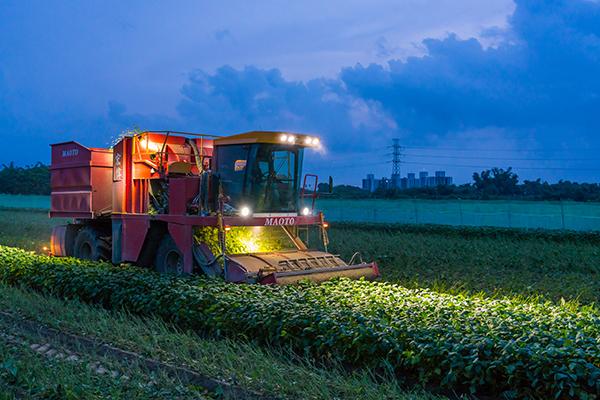Autumn marching pest disaster: the correct way of regional prevention and control of autumn army insects in Taiwan, how high is the reproductive ability of autumn army insects
The Emergency response team for Autumn military and insect disasters (referred to as the Emergency response Group) of the Council of Agriculture explained today (23) that as of the 22nd, 155 cases of autumn military pests in Taiwan have been confirmed. President Tsai ing-wen and the response team of the Council of Agriculture inspected Chiayi County. According to the response team, of the more than 5,000 cases of autumn military insects reported by the public, 147 have been dealt with with the joint efforts of all Taiwan county and municipal governments, including 76 cases of destruction and 71 cases of spray control, with a treatment efficiency of 95%.
"when the autumn army insects first discovered this problem, the central government, especially the Council of Agriculture, began to be very vigilant. After the burial and burning of the first stage, to the second stage of compulsory pesticide spraying, it has now reached the stage of establishing independent management. I would like to appeal once again that we must be of one mind, the central and local governments must face the problems together, and let the local governments prepare manpower and materials to cooperate with the central government, so that the hard-working farmers will not suffer too great losses. we have just heard that the Council of Agriculture has provided compensation measures for farmers whose corn harvest has been affected, and we also hope that this is a very efficient measure so far. If it can be sustained, we must make sure that the harm caused by this autumn military pest in Taiwan can be reduced to a minimum, so that we farmers can lose the least. " President Cai made a speech after listening to the report of the response team and Weng Zhangliang, head of Chiayi County.
The response team pointed out that since the autumn army insect has already propagated in the second generation, two major directions should be paid attention to in independent management. the first is the evaluation of pesticides: in the past, the autumn army insect did not enter Taiwan, so the bureau did not have much experience. For example, the behavior of this insect creature and its habits, so in the second stage, efforts should be made to develop the effectiveness of pest control. With regard to Taiwan's three species of Spodoptera litura, including Spodoptera litura, Spodoptera litura, and Spodoptera exigua, all parties already have very good control techniques, combined with the development of integrated autumn army pest control technology in the future. the bureau will expect to maintain the best efficiency at the lowest cost. Second, it is necessary to establish a good monitoring network, because Taiwan's agricultural land is very small, regional prevention and control is the correct way of prevention and control.
In view of the strong fecundity of army insects in autumn, there are 100,200 eggs in an egg mass, and a female adult can lay as many as 1000 eggs, so the inspection and removal of egg blocks or larvae is a very important work in epidemic prevention. At present, autumn military pests occur only in corn plants. The response team calls on farmers to strengthen field inspection, pick up egg blocks and larvae, and carry garbage bags with them during inspection, and find suspected egg blocks and insect bodies to be removed and destroyed. The three key points of inspection include: (1) visually inspect whether the leaves are damaged, pay special attention to the growing points and parts of the heart leaves, and then get close to check if there are insect feces (2) inspect the lower leaves to see if there are egg blocks. Check whether the leaves are eaten by young insects. (3) mature plants carefully check the corn ear drilled holes and insect dung, and then pluck the corn ear for detailed inspection.

Corn ears eaten by autumn army insects

Autumn army insects (left) and pupae (right)
- Prev

Economic development model under forest: beekeeping in forest land makes a fortune? What are the prospects for beekeeping in woodland?
On April 18, the Agriculture Committee officially released the application project for economic undertakings such as under-forest economy, among which the opening of beekeeping in forest land made many people eager to try, and many people asked the Forestry Bureau about relevant regulations in two months. However, the Forestry Laboratory cautions that in addition to considering whether nectar plants
- Next

Freezing edamame beans in the golden corridor to slow down the subsidence of strata along the high-speed railway
Freezing edamame beans in the golden corridor to slow down the subsidence of strata along the high-speed railway
Related
- A course of planting techniques and methods on how to grow carrots
- How to plant the latest tulips?
- Is it better to pick tea in the morning or in the afternoon? When is the best time for tea to be picked? what is the third or fifth tea?
- Launch Yuanxiao Happy combination Haocha + Tea Yuan healthy Taste
- Penghu Tourism "Fireworks 20 Parade with You"
- 2022 West Lake Happiness holds "Digital Revitalization Voucher" and draws iphone13 and laptop.
- Banqiao Fuzhou social houses are designed to change start-up combined with police elimination to create a safe and livable environment
- The convenient measure of "mechanical weeding" in Xinbei has been abused and the Agriculture Bureau has imposed heavy penalties on the illegal land consolidation.
- Changgeng University Joins Hands with Four Memory Factories to Rescue Memory Talent Shortage
- The list of Taiwan's top 100 MVP managers is listed by the Director-General of the Farmers' Association of Sanxia District.

